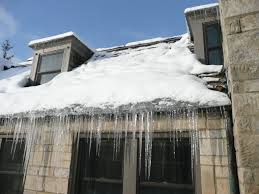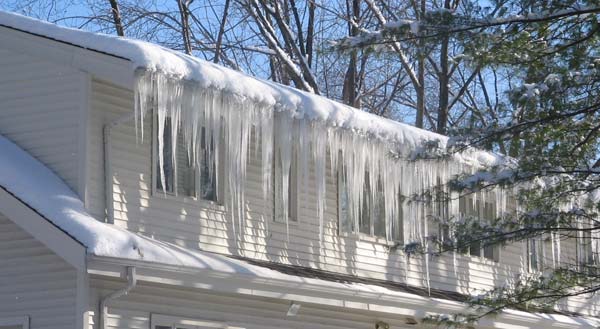It’s not bad enough that we are stuck in the house while mounds and mounds of snow pile up outside our doors but do we really have to suffer actual physical damage incurred by the storms, too? Statistics show that in the Boston area alone, homeowners will suffer detrimental costs rising above 2.4 million dollars due to the destruction of snow, ice and water that a winter season will produce. New Englanders have seen it all including flooded basements, leaky roofs, and my favorite- ice dam destruction. Recently over the last storm, my home was affected by this annoying, depressing and expensive form of winter weary, which ruined not only the above ceiling panel but also the freshly coated paint that I applied during the first snowstorm.

photo credit: Wikipedia
But what actually is an ice dam? How does it occur?
Ice dams are formed when icicles are produced on the eaves after snowfall has accumulated on a building’s roof. They might look beautiful but the truth is, the ice stops a gutter’s natural water flow from evacuating the area of a house properly, which causes water leakage into the home. Common outcomes of damage caused ice dams include sagging roofs, ceiling leakage and at the very least wood and wall rot. Severe circumstances can also affect the attic where water seeps into the structure, eventually producing mildew and mold, a serious health hazard for you and your family.

photo credit: bobvila.com
So now that we all know what an ice dam is, what can we do to fix the problem if it occurs? Well, my favorite answer that I received after my own situation was, “nothing”. You have to have to wait until the snow and ice melt from your roofs and honestly, if you first see the signs that this kind of disaster is occurring, you just might have to wait it out until repairs can be made during better weather.
Can Bostonians be proactive before an ice dam occurs?
 photo credit: structuretech1.com
photo credit: structuretech1.com
Well, through careful research, experts have made a few suggestions that might defer this nasty winter effect but unfortunately, most of the advice only pertains to homes that are low enough to the ground to reach the upper gutters. Building contractors have offered the advice to take women’s nylons and fill them with calcium chloride. Lay them across the areas where ice dams could erupt and this should stave off the freezing until the storm passes. Ice rakes can also be used to scrape off the snow from shingles that are reachable. If you are like me with a roof height too distant to reach with a rake or utility ladder, you have to think about using heated cables to defrost ice dams and prevent chronic episodes. Place them in a zigzag pattern across your shingles and cross your fingers. They just might work!
Suzie Canale,
Westwood, MA
Suzie has been actively breaking iciciles, raking snow and catching the drips at her home in Westwood, MA.
